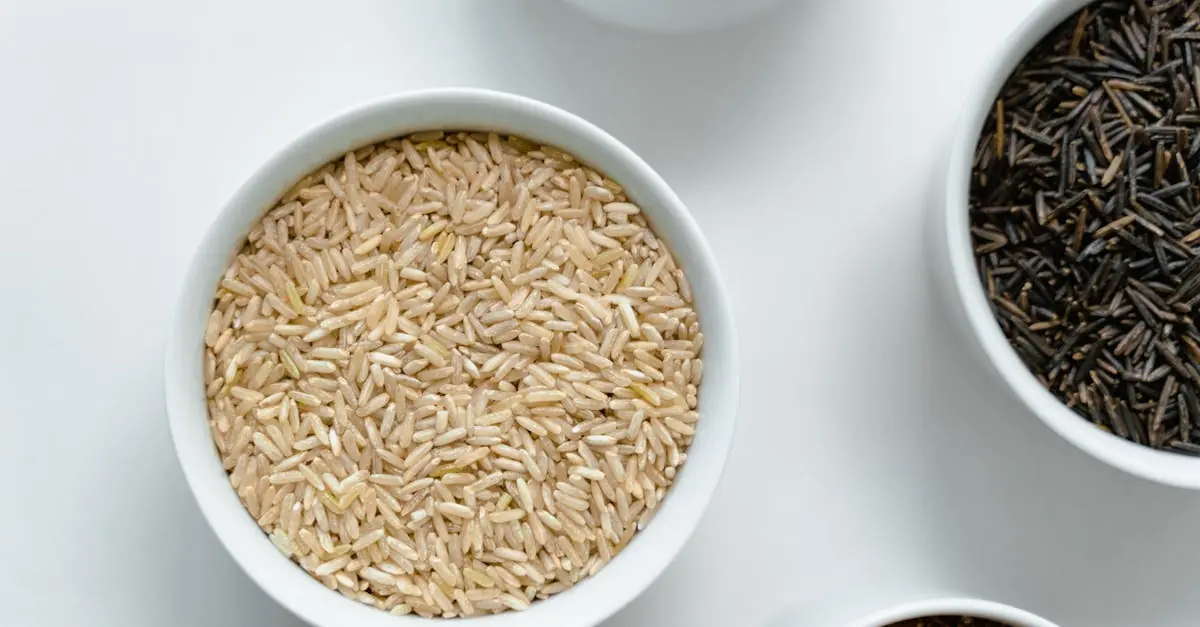Brown basmati rice is like that friend who shows up to the party late but brings the best snacks. Packed with nutrients and a nutty flavor, it’s the healthier alternative to its white counterpart. But let’s be honest—cooking it can seem like a daunting task, especially when you’re juggling a million other things. Fear not! With the right instructions, you’ll transform this humble grain into a fluffy, aromatic side dish that’ll steal the show.
Table of Contents
ToggleOverview of Brown Basmati Rice
Brown basmati rice offers a range of nutritional advantages, making it a popular choice for health-conscious individuals. This whole grain variant retains the bran and germ layers, resulting in higher fiber content compared to its white counterpart. Fiber aids in digestion and promotes a feeling of fullness, which supports weight management.
Cooks often value brown basmati rice for its distinct nutty flavor and fragrant aroma. These qualities enrich a variety of dishes, from curries to stir-fries. Its long, slender grains remain separate when cooked, enhancing presentation and texture.
Preparing brown basmati rice requires a different approach than cooking white rice. While it may take longer to cook, the payoff in taste and nutrition is considerable. Standard cooking ratios suggest using two cups of water for each cup of rice. Adjustments may be necessary based on individual preferences and equipment.
Cooking methods also vary. Some prefer simmering on the stovetop, while others utilize a rice cooker for convenience. Timing becomes crucial, with a typical cooking time ranging from 30 to 40 minutes. Soaking the rice for 30 minutes can further improve its texture and reduce cooking time.
Brown basmati rice, when paired with vegetables and proteins, creates a wholesome meal. It integrates well into various culinary traditions. Incorporating this rice into a diet not only enhances flavors but also boosts overall nutrition.
Nutritional Benefits of Brown Basmati Rice
Brown basmati rice is known for its rich nutritional profile. This rice variety not only satisfies hunger but also offers numerous health benefits.
High Fiber Content
High fiber content characterizes brown basmati rice. Each cup holds about 3.5 grams of dietary fiber. Such fiber aids digestion and helps maintain a healthy gut. Additionally, fiber promotes a sense of fullness, reducing the chances of overeating. It supports weight management effectively. Many individuals find that incorporating high-fiber foods like brown basmati rice into their meals leads to healthier eating habits. This rice is a smart choice for those looking to enhance their diet.
Essential Nutrients
Essential nutrients abound in brown basmati rice. Each serving provides important vitamins and minerals like magnesium, phosphorus, and selenium. Magnesium supports bone health and energy production. Phosphorus contributes to cell function and tissue repair. Selenium acts as an antioxidant, protecting the body from damage. Brown basmati rice also contains B vitamins, aiding metabolic processes and providing energy. Such a wealth of nutrients makes it an excellent addition to balanced meals, ensuring optimal nutrition and health benefits.
Preparing to Cook Brown Basmati Rice
Preparing brown basmati rice involves careful selection and proper soaking techniques. These steps contribute significantly to achieving the best possible flavor and texture.
Choosing the Right Rice
Selecting high-quality brown basmati rice enhances cooking results. Look for grains that are long and slender, which signifies a premium product. Brands may vary in quality; thus, consider well-reviewed options from reputable manufacturers. Organic varieties often contain fewer additives and pesticides, making them a healthier choice. Also, check for freshness by examining packaging dates. Freshness influences flavor and cooking performance.
Washing and Soaking
Washing brown basmati rice removes surface starch that leads to gumminess. Rinse the rice thoroughly under cold water until the water runs clear. This process may involve rinsing several times to ensure all excess starch is eliminated. After washing, soaking the rice for 30 minutes softens the grains and helps reduce cooking time. Submerge the rice in water, allowing it to absorb moisture evenly. Soaking improves the final texture, creating fluffier rice.
Cooking Brown Basmati Rice
Cooking brown basmati rice can yield a delicious and nutritious side dish. Two primary methods exist: stovetop and rice cooker, each producing fluffy results.
Stovetop Method
Start by rinsing one cup of brown basmati rice under cold water to remove excess starch. After this, soak the rice in water for 30 minutes to enhance its texture. In a pot, combine the soaked rice with two cups of water and a pinch of salt. Bring the mixture to a boil over medium heat. Once it reaches a boil, reduce the heat to low, cover the pot, and let it simmer. Typically, cooking takes about 30 to 40 minutes. Afterward, remove the pot from heat and let it sit covered for 10 minutes, allowing the rice to steam. Fluff with a fork before serving.
Rice Cooker Method
Using a rice cooker simplifies the process. First, rinse one cup of brown basmati rice under cold water. Soaking for 30 minutes remains beneficial for texture. Place the soaked rice in the rice cooker and add two cups of water. Adding a pinch of salt enhances flavor. Set the rice cooker to the brown rice setting, and it will automatically cook the rice. Cooking typically lasts around 40 to 50 minutes. After the cooker indicates completion, allow the rice to sit for an additional 10 minutes before opening. Fluffing the rice with a fork brings out its nutty aroma and delicious texture.
Tips for Perfectly Cooked Brown Basmati Rice
Achieving perfectly cooked brown basmati rice requires attention to specific details. Following the right guidelines ensures a delightful dish.
Water-to-Rice Ratio
Using the correct water-to-rice ratio is key for optimal cooking. A common recommendation is two cups of water for each cup of brown basmati rice. This ratio helps ensure the grains absorb enough moisture and become tender. Adjustments may be necessary based on the cooking method or personal preference. Some cooks prefer slightly more water for a softer texture. Experimenting can lead to a tailored outcome that suits individual tastes.
Cooking Time
Timing significantly impacts the final texture of brown basmati rice. Typically, the cooking time ranges from 30 to 40 minutes using the stovetop method. During this phase, simmering allows the grains to cook evenly. The rice cooker tends to take a bit longer, usually around 40 to 50 minutes. Letting the rice rest after cooking is equally important, as it enhances the fluffiness and flavor. Proper timing results in rice that’s light, airy, and delicious.
Brown basmati rice stands out as a nutritious and flavorful choice for any meal. With its higher fiber content and essential nutrients, it offers significant health benefits. Mastering the cooking techniques outlined ensures that anyone can enjoy its unique taste and fluffy texture.
By paying attention to water ratios and cooking times, it’s possible to achieve delightful results. Whether using a stovetop or rice cooker, the key lies in proper preparation and resting time. Incorporating brown basmati rice into daily meals not only enhances flavor but also supports a balanced diet. Embracing this wholesome grain can transform everyday dishes into nutritious delights.




